|
Thursday, Nov. 8
10 a.m.
Research Techniques Seminar - Curia II
Speaker: A. Para, Fermilab
Title: First Look at the Hamamatsu MPPC
11 a.m.
Academic Lecture Series - One West
Speaker: G. Landsberg, Brown University
Title: Experimental Signatures for Extra Dimensions in Space – Part 2
THERE WILL BE NO ILC ALCPG PHYSICS AND DETECTOR SEMINAR THIS WEEK
2:30 p.m.
Theoretical Physics Seminar - Curia II
Speaker: F. Tackmann, Lawrence Berkeley National Laboratory
Title: GenEvA: A New Framework for Event Generation
3:30 p.m.
DIRECTOR'S COFFEE BREAK - 2nd Flr X-Over
4 p.m.
Accelerator Physics and Technology Seminar - One West
Speaker: A. Dragone, Brookhaven National Laboratory
Title: Monolithic Signal Processing for Radiation Detectors: Late Developments at BNL
Friday, Nov. 9
3:30 p.m.
DIRECTOR'S COFFEE BREAK - 2nd Flr X-Over
4 p.m.
Joint Experimental-Theoretical Physics Seminar - One West
Speaker: E. Varnes, University of Arizona
Title: Measurement of the W Boson Helicity in Top Quark Decays at DZero
Click here for NALCAL,
a weekly calendar with links to additional information.
|
Thursday, Nov. 8
- Santa Fe black bean
- Sloppy joe
- Chicken cordon blue
- Steak
- Baked ham & swiss on a ciabatta roll
- Assorted slice pizza
- Crispy fried chicken ranch salad
Wilson Hall Cafe menu |
|
Thursday, Nov. 8
Dinner
- Closed
Wednesday, Nov. 14
Lunch
- Pork satay w/peanut sauce
- Sautéed asian vegetables
- Steamed jasmine rice
- Banana spring rolls
Chez Leon menu
Call x4598 to make your reservation. |
|
|
|
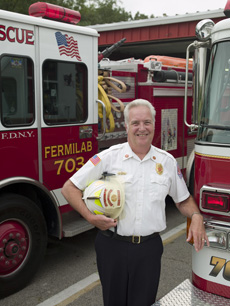
Jack Steinhoff - Chief of the Fermilab Fire Department in the Business Services Section
"Everywhere you go, observe where the exits are located -- at home, at work, on vacation, in a hotel and when you are shopping. Plus, periodically practice your escape plan. Smoke can disorientate even firefighters, so practice now prevents a panicked search for a way out later."
See all Fermilab Profiles in Safety here.
|
Education volunteer nominations due Nov. 21
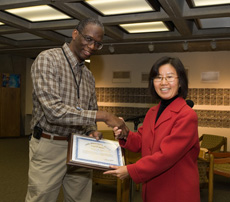
PPD's Curtis Danner accepts the 2006 Director's Award from Deputy Director Young-Kee Kim last year. Danner received the award for his contributions building and maintaining exhibits in the Lederman Science Center.
During the past year, Fermilab has had more than 200 volunteers who have helped to keep the education programs working like well-oiled machines. Whether they are maintaining exhibits at the Lederman Science Center or answering tough questions about the laboratory and its science, the education volunteers are major contributors to Fermilab's successful K-12 education programs. Once a year, at the Director's Volunteer Reception, these same volunteers are recognized for their efforts.
"The reception is to honor everyone who helps us throughout the year," said Spencer Pasero of Fermilab's Education Office. "We had more than 200 volunteers helping us this year and this gives extra recognition to those who go above and beyond."
Each year at an annual reception, one especially dedicated volunteer is awarded the Director's Award for his or her efforts. To nominate a candidate for this award, download a nomination form. Completed forms must be submitted to to Carol Angarola or Gayle Millman by Nov. 21 to be considered for the 2007 award. Nominees must be a Fermilab staff member, user or contractor.
Nominations will be chosen by a selection panel. The Director's Volunteer reception will take place on Dec. 6. Director Pier Oddone will present the winner with an award of $1,000, made possible by an anonymous donor.
|
Distributed security: keeping Open Science Grid closed to intruders
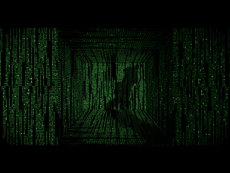
“A feeling of false safety is much more dangerous than always being on our toes.” Head of OSG Security Mine Altunay says constant vigilance is essential.
Images courtesy of Marcos Papapopolus
One of the most essential parts of operating the Open Science Grid is keeping it closed.
Closed to malicious intruders.
And protected from inadvertent as well as malevolent attack.
Head of OSG Security, Mine Altunay, says she’d always prefer to be safe than sorry.
“A feeling of false safety is much more dangerous than always being on our toes,” Altunay says.
“So far we’ve never had an incident that has prevented us from running, but this doesn’t mean we don’t have vulnerabilities. We are constantly thinking of our response to potential incidents: Will our communications channels be open? Is our technical knowledge up to date? Will everybody know what to do?” Read More
|
LHC completes the circle
From CERN press release, Nov. 7, 2007
At a brief ceremony deep under the French countryside today, CERN Director General Robert Aymar sealed the last interconnect in the world’s largest cryogenic system, the Large Hadron Collider (LHC). This is the latest milestone in commissioning the LHC, the world’s most powerful particle accelerator.
The LHC’s cryogenic system has the task of cooling some 36 800 tonnes of material to a temperature of just 1.9 degrees above absolute zero (–271.3°C), colder than outer space. To do this, over 10 000 tonnes of liquid nitrogen and 130 tonnes of liquid helium will be deployed through a cryogenic system including over 40 000 leak-tight welds. Today’s ceremony marks the end of a two year programme of work to connect all the main dipole and quadrupole magnets in the LHC. This complex task included both electrical and fluid connections.
“This is a huge accomplishment,” said Lyn Evans, LHC project leader. “Now that it is done, we can concentrate on getting the machine cold and ready for physics.”
Read More
|
|
|
Closing in on the Higgs
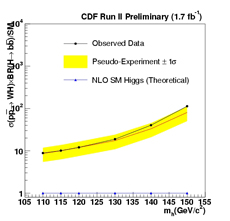
This figure shows the ratio of the 95 percent confidence level upper limit on Higgs production obtained by this analysis. The black points show the limit we observe in the data while the yellow band shows our range of expected limits assuming the Higgs isn't really there. Because our observed limit is consistent with this expectation, we conclude that there is no sign of Higgs yet.
At times, it seems like the Standard Model of particle physics has all the answers. It tells us where particle masses come from. It tells us how three of the four fundamental forces of nature work. The only problem is that standing at the center of most of these answers is the one piece of the Standard Model that hasn't been discovered yet: the Higgs boson.
Indirect evidence suggests the Higgs mass is probably less than 144 GeV/c2. Over most of this range, the Higgs usually decays to a pair of bottom quarks. However, the backgrounds to this Higgs signature are huge. One approach to deal with these large backgrounds is to search for Higgs being produced together with another particle. One team of scientists from CDF has taken the next step towards closing in on the Higgs by releasing the new results from a search for Higgs produced along with a W boson.
Although their analysis doesn't see signs of the Higgs yet, it has about 1.7 times more reach than the previous results from CDF in this channel. Only about half of this improvement comes from collecting more data. The rest comes from a combination of improvements to the analysis methodology, like improved bottom quark identification and the use of a sophisticated analysis technique, an artificial neural network, to help separate the small Higgs signal from the huge backgrounds. Improvements like these are essential in continuing to close in on the Higgs boson.
The results from this search are still about a factor of ten away from being able to find the Higgs, but CDF still plans to collect three to four times as much data as it has now, and there are plenty more tricks that haven't been tried yet. Furthermore, by combining these results with other search channels, hopes remain high for closing in on a discovery.
Read more
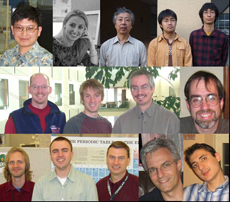
From left to right, from the top: Wei-Ming Ya, LBNL; Anyes Taffard, UC Irvine; Shinhong Kim, Tatsuya Masubuchi and Yoshikazu Nagai, University of Tsukuba; Richard Hughes, Jason Slaunwhite, Brian Winer and Kevin Lannon, Ohio State University; Nils Krumnack, Martin Frank and Jay Dittmann, Baylor University; Andreas Warburton and Adrian Buzatu, McGill University.
Result of the Week Archive
|
Green light for new particle accelerator
From Spiegel Online, Nov. 7, 2007
Scientists from around the world are gathered in the German city of Darmstadt on Wednesday to kick off the construction of a new €1.2 billion particle accelerator. They plan to use the facility in an effort to recreate the conditions of the Big Bang.
One way to figure out what might have happened during the Big Bang -- that massive explosion of matter and energy that physicists think might have marked the birth of the universe -- is to spend hours in front of a chalkboard working through massively complicated formulae.
The other, of course, is to go out and create a Big Bang yourself. That is the route to be taken by German researchers along with their particle physics colleagues from over a dozen countries around the world.
Read More
|
|
Have a safe day!
Wilson Hall building closed Sunday
A scheduled power outage will affect all floors of Wilson Hall on Sunday, Nov. 11, between 7 a.m. and 5 p.m. The outage is necessary for annual feeder 44 maintenance. The building will be closed during the outage. Please remember to power down all essential electronics at the close of business this Friday.
Project X physics workshop Nov. 16-17
Fermilab will host a users' workshop Nov. 16-17 to discuss the physics of Project X.
The group will meet at 8:30 a.m. Friday, Nov. 16, in One West. A wine and cheese talk by Michelangelo Mangano runs from 4 to 5:30 p.m. The Saturday session will be partly in One West, but also will include parallel sessions in different rooms. Streaming video of the sessions will be provided.
The agenda can be found here.
You should register if you plan to attend in person or via streaming video. Online registration is available.
EAP office hours temporary change
The EAP office will be closed Wednesday, Nov. 7, and Friday, Nov. 9. The EAP office will resume the regular schedule on Wednesday, Nov. 14. The EAP is available 24/7 by calling (800) 843-1327.
Additional Activities |
|